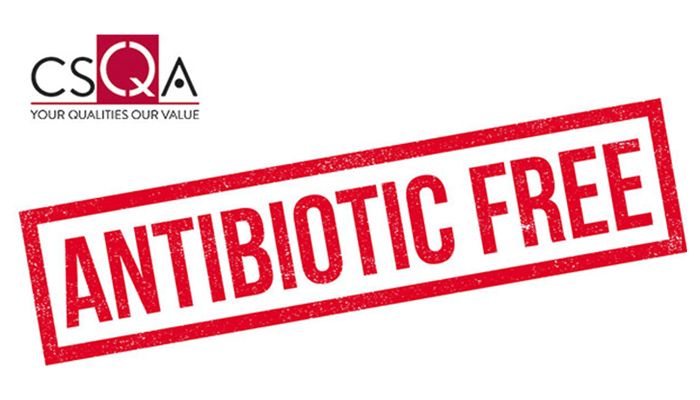
THE “ANTIBIOTIC FREE” CERTIFICATION
The CSQA certification project of a supply chain from animals raised "without antibiotics" stems from the request of various companies in the sector to ensure - also through evaluation by a third party - the production of animal products (milk, eggs, meat) from animals that have not undergone antibiotic treatments during the breeding phase.
The certification therefore becomes a tool for defining the rules against which it is possible to communicate the "absence of antibiotics" and for demonstrating the company's due diligence in managing and communicating this specific requirement. From this point of view, the choice of some companies to undertake a certification project aimed at the elimination of antibiotics in breeding is virtuous.
In order to support companies in this process, CSQA has prepared three voluntary standards for pork and derivatives ( DTP 109) , poultry meat and derivatives ( DTP 116 ), eggs and derivatives ( DTP 127 ) which allow to support the claims "raised antibiotic free" or "raised without antibiotics".
The implementation of these standards makes it possible to demonstrate that the meat and its derivatives are obtained from animals that have not undergone antibiotic treatments on farm, through a much more restrictive approach than that required by law (which instead allows the use of antibiotics by using them in accordance with defined rules).
The guarantee of antibiotic-free breeding can cover the entire life of the animal or a part of it, especially in the case of animals with a medium-long life cycle. To ensure clear and transparent information to the consumer, the claim " bred without antibiotics " is allowed only if the animal has not undergone antibiotic treatments throughout its life cycle (starting from birth).
Where the guarantee concerns only one phase of the life cycle (for example the last 4 months) it is mandatory to report this specific limitation on the label, e.g. "farming without antibiotics for the last 4 months" as happens in some cases for the pig or cattle sector [1]
The management of the "antibiotic-free" requirement takes place at the farm level, while in the subsequent phases it is required to implement a traceability system that ensures the maintenance of the chain of custody in all stages of the process , and therefore the maintenance of the identification and separation of the product made from farms " without antibiotics " compared to the conventional product.
Certification is an important tool to support corporate marketing to meet the needs of consumers who are increasingly aware and attentive to issues relating to the broad sphere of sustainability and health. Indeed, the use of the claim and the support of the certification ensure transparent communication on the subject of antibiotics .
TO KNOW MORE
WHY THIS CERTIFICATION
As specified by the Ministry of Health in the " Manual [2] - Biosafety and correct and rational use of antibiotics in animal husbandry " antibiotics in the veterinary sector, since the 1950s and still today, represent a fundamental means for the control of infectious diseases in this sector. Their introduction has contributed to the improvement of animal welfare and represents an important means of guaranteeing the standard of food production of animal origin.Seventy years later, these applications are challenged by the emergence of the phenomenon of antibiotic resistance.
The inadequate use of therapeutic antimicrobials in human and veterinary medicine can have negative effects on products, the environment and also on the emergence and spread of resistant microorganisms, leading to serious consequences.
Any drug for veterinary use must be used in full compliance with the law; it must be used responsibly, on the basis of an examination of the animal by the veterinary surgeon who establishes the diagnosis and prescribes with his own prescription the type of drug authorized for that animal species, necessary to treat the ascertained pathology.
The responsible use of the drug involves several subjects: the pharmaceutical companies, the manufacturer, the public veterinary service, the freelance veterinary surgeon and the breeder.
In some countries, approximately 80% of the total consumption of medically important antibiotics occurs in the animal sector, mainly to promote the growth of already healthy animals.
At an international level, there is great attention on the topic and a strong commitment to the responsible management of medicines and the reduction of their use.
WHO recommends a "general reduction in the use of all classes of antibiotics important in medicine in food-producing animals". ( DOWNLOAD WHO GUIDELINES 2017 ).
In Italy there is a National Plan to Combat Antimicrobial-Resistance (PNCAR) 2017-2020 . The Ministry of Health has published a Manual for biosafety and the correct and rational use of antibiotics in animal husbandry of the Ministry of Health and the European Guidelines on the prudent use of antibiotics in veterinary medicine have been published.
On the entrepreneurial front, some companies - particularly sensitive to the issue - have adopted projects aimed at reducing antibiotics to the point of excluding them from farms following breeding techniques aimed at animal welfare and disease prevention.
[1] In the case of beef, the requirement " bred without antibiotics for the last [X] months " is permitted by the MIPAAF - Ministry of Policies - only following the approval of a specific company specification pursuant to reg. EC 1760/00 and subsequent DM 876/15
[2] Advice on the responsible use of antibiotics